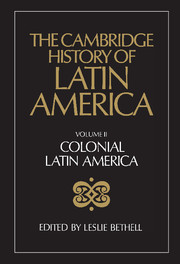Book contents
- Frontmatter
- PART ONE POPULATION
- PART TWO ECONOMIC AND SOCIAL STRUCTURES: SPANISH AMERICA
- 3 The urban development of colonial Spanish America
- 4 Mining in colonial Spanish America
- 5 The formation and economic structure of the hacienda in New Spain
- 6 The rural economy and society of colonial Spanish South America
- 7 Aspects of the internal economy of colonial Spanish America: labour; taxation; distribution and exchange
- 8 Social organization and social change in colonial Spanish America
- 9 Women in Spanish American colonial society
- 10 Africans in Spanish American colonial society
- 11 Indian societies under Spanish rule
- PART THREE ECONOMIC AND SOCIAL STRUCTURES: BRAZIL
- PART FOUR INTELLECTUAL AND CULTURAL LIFE
- Bibliographical essays
- References
8 - Social organization and social change in colonial Spanish America
from PART TWO - ECONOMIC AND SOCIAL STRUCTURES: SPANISH AMERICA
Published online by Cambridge University Press: 28 March 2008
- Frontmatter
- PART ONE POPULATION
- PART TWO ECONOMIC AND SOCIAL STRUCTURES: SPANISH AMERICA
- 3 The urban development of colonial Spanish America
- 4 Mining in colonial Spanish America
- 5 The formation and economic structure of the hacienda in New Spain
- 6 The rural economy and society of colonial Spanish South America
- 7 Aspects of the internal economy of colonial Spanish America: labour; taxation; distribution and exchange
- 8 Social organization and social change in colonial Spanish America
- 9 Women in Spanish American colonial society
- 10 Africans in Spanish American colonial society
- 11 Indian societies under Spanish rule
- PART THREE ECONOMIC AND SOCIAL STRUCTURES: BRAZIL
- PART FOUR INTELLECTUAL AND CULTURAL LIFE
- Bibliographical essays
- References
Summary
Less than two decades ago the topic that we now often call the ‘social history’ of early Spanish America, the study of its ‘social structure’ or ‘social organization’, was just beginning to be explored; a single thoughtful article was able to bring together nearly everything useful that was then known, most of it drawn from formal, self-conscious statements of contemporaries in laws, tracts, political manifestos, or official reports. Since then a whole current of scholarship within the field of early Spanish American history has concentrated on precisely the opposite kind of social phenomena, informal patterns of thought and behaviour which were rarely given overt expression-some, indeed, may have been beneath the level of consciousness. Such work has been highly specific, tied to a certain time and place, giving detailed accounts of individual lives and individual families, businesses, or other local organizations in different periods and different regions. The cases were sometimes chosen for their representation of general types and processes, but the typological aspect often remained implicit.
The time has now come for a provisional synthesis. The emphasis will be on processes and principles, although individual life stories and individual situations have ultimately provided the raw material. It may be felt by some that the colour — the humanity — is missing, that the regional variety has been attenuated, or that aspects of the chronology have been neglected. The first part of this chapter deliberately sets out to examine general patterns of social organization in a somewhat atemporal fashion.
- Type
- Chapter
- Information
- The Cambridge History of Latin America , pp. 265 - 320Publisher: Cambridge University PressPrint publication year: 1984
References
- 7
- Cited by

